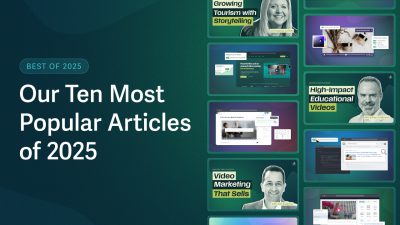Producing original video content is hard work that can require a large investment of time and money … and failure usually isn’t an option. However, knowing how to use the correct planning documents is the secret to any production’s success. Using the right apps and tools to create these documents will greatly simplify your video production process, and can be the difference between a successful project, and one that bogs down, finishes late, goes over budget, or fails outright. The hardest shoots can become much easier with proper planning, and we’re here to help.
First, we’ll introduce you to the 10 essential planning documents that cover every stage of video content production, from brainstorming, through wrap. Next, we’ll look at each phase of production, and cover some of the most useful apps for creating and organizing the planning documents you’ll need.
The 10 Essential Content Planning Documents
- Creative Brief: a marketing document that outlines the strategy of a creative project. It may include a description of the audience, deliverables, and publication channels.
- Treatment: a pitch deck that summarizes the message and tone of a project.
- Mood Board: a collage of images and text that conveys the general look and feel of a project, sometimes integrated into the treatment.
- Script: a written description of all the words and actions that will take place in a video or animation project.
- Shot List: a breakdown of the video or animation script into a list of shots. For photography, this is a list of images in the project. It also includes information about what is required for each shot.
- Storyboard: a visual sketch of each shot in each scene of the script.
- Stripboard Shooting Schedule: a master top-down schedule of your shoot, where each strip (or row) represents a scene or a shot.
- Day out of Days Report (DOOD): most often used on longer shoots and bigger productions, this is a grid that marks the beginning, middle, and end of each actor or model’s time on set.
- Call Sheet: a one- or two-page document that includes the most important information for the shoot day, such as shot schedule, location, crew list, contact information, and even the weather forecast.
- Production Report: a daily summary briefing of each completed shoot day, including payroll obligations, shots covered, any delays or overages, talent and location releases, and more.
Phase 1: Creative Brief, Treatment, and Mood Board
Let’s begin at the first step for creative teams: the concept. The creative brief will provide the creative team with its project goals. Once that document is in hand, it’s time to collect your team’s scattered ideas into a clear, creative concept. This process typically begins with a treatment. For some film projects, a treatment can be a text-only document that you can create in any text editor or script software (listed below). However, for commercial video projects, photography projects, or social projects that may include a mix of motion and still images, the treatment can become a complicated, visually-rich pitch deck that includes a mood board.
These tools can help simplify the task of making a compelling visual treatment:
- Canva (web app) is a powerful tool that makes it easy for non-designers to create clean, eye-catching presentations.
- Visme (web app), much like Canva, makes the process of creating designs and layouts a painless, turnkey process.
- Milanote (web app) is a tool to organize your creative products into a visual board.
- Shotdeck (web app) gives you access to thousands of film clips for decks for pitches, treatments, etc. to help you fill your document with existing visual content that fits your project’s mood.
- Pinterest (web app) is not just for accent walls and sconces; it will help collect all your reference and inspiration imagery in one place when planning your mood board and treatment presentation.
Phase 2: Script and Shot List
Once the treatment is approved, you’ll move on to the script. And from your script, you’ll make your shot list. For commercial projects with little or no narration or dialogue, a Google doc might seem like the easiest choice for writing out script ideas. It’s free, there’s no learning curve, and it’s an easy collaboration tool. But proper script formatting can be very important, and the proper formatting in script software will make it much easier to convert your script into your shot list, and then turn your shot list into the next planning documents your shoot will require.
Some script software will organize your entire project by using your script to break scenes down into a shot list, inform your storyboard, populate your shooting schedule, establish your budget, and plug your project info into a call sheet to keep your shoot days organized.
All-in-One Scripting and Project Management
- StudioBinder (web app) is the leading film production management software that also includes a scripting component. Overall, StudioBinder has tools for everything from scripting, storyboarding, budgeting, shot listing, scheduling, and creating call sheets. However, the subscription can get pricey if you want to collaborate.
- Celtx (web app, Mac, Windows, iOS, and Android) is a subscription-based platform that started as script software, and now includes a lot of project management tools and mobile apps.
Standalone Scripting
- Final Draft (Mac, Windows, and iOS) is the de facto standard of the film and television community. It’s pricier than most, and probably best for creatives that need to collaborate at the higher end of the film and TV industry.
- WriterDuet (web app) is a free script application that makes collaboration easy.
- Arc Studio (web app, Mac, Windows, and iOS) offers a free browser-based option, or more feature-rich premium desktop and mobile versions.
- Trelby (Windows) is a free, lightweight scripting option.
Phase 3: Storyboard
Once you have a script, it’s time to storyboard. Let’s be honest; very few content creators also happen to be gifted illustrators. For the rest of us challenged scribblers, storyboards can be daunting! Using stock photography, clipart, location scouting shots, and other off-the-shelf visuals to represent each shot can save you from having to … you know … actually draw.
Here are some great tools to help make storyboarding more manageable:
Storyboard Illustration
- Procreate (iOS) is a feature-rich industry standard for professional tablet illustration.
- Photoshop (Mac, Windows, and iOS) is the industry standard for professional desktop illustration. It can be overwhelming for non-illustrators and may require extra tools like a Wacom tablet for illustration.
- Paper (iOS) is free, and lighter on features. However, anyone outside of professional artists and experienced illustrators won’t miss the extra functionality.
Storyboard Layouts
- Storyboarder (Mac and Windows) is a free app with stellar reviews and robust features that integrates with Photoshop for image creation, as well as Premiere, Final Cut, and Avid for creating animatics from your boards.
- Studiobinder and Celtx are also fantastic storyboarding and shot listing tools. (Just a reminder.)
- Boords (web app) is another good option, with collaboration tools and an animatic feature.
- Plot (web app) is a simple subscription-based storyboarding app with fewer features and a lower price point.
How Experts Turn Video Views Into Profit

Tired of videos that feel like a rigged carnival game? Discover expert strategies for turning video into a growth engine across any industry.
Phase 4: Shooting Schedules, DOODs, Call Sheets, and Production Reports
The creative is signed off and your project is greenlit. Now, it’s time for the final step: planning and logistics. If your script and storyboard are the heart of your shoot, these documents are its brain. First, you’ll order your shot list into a shooting schedule and , if your shoot is big enough to require one, a DOOD (day out of days). Next, you’ll create a call sheet for each shoot day that covers the shots on the shooting schedule for that day, as well as the rest of the information your cast and crew will need. Finally, when your shoot day is wrapped, you’ll make a production report that summarizes all the important shoot information for your records. It’s worth investing time and effort into these documents because the success of your shoot ultimately relies on them.
Here are the best apps to make this process easy:
- Set Hero (web app and iOS) is a call sheet and crew contact management software with subscription or per-project pricing.
- Studiobinder (web app) lets you send call sheets directly to mobile apps so your crew has up-to-date information on locations, schedules, and shots.
- Yamdu (web app) offers call sheet generation, contact management, scheduling, and more. Subscription pricing of this app is higher than others.
- Celtx (web app, Mac, Windows, iOS, and Android) has less functionality than the apps above, but might be worth using if budget is a consideration and you’re already using Celtx for other elements of your project.
Find the tools and apps that are right for you, and start working on these documents early. The more time you invest into these planning documents before you begin shooting, the easier your shoot day(s) are likely to be.








